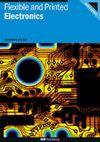在退墨基底组合上喷印窄迹的种子和桥层方法
IF 3.2
4区 工程技术
Q3 MATERIALS SCIENCE, MULTIDISCIPLINARY
引用次数: 0
摘要
电子材料的喷墨打印对于柔性电子器件和传感器的数字打印很有意义,但喷墨打印的线宽仍然很大,限制了器件的尺寸和性能。减少墨滴量、增加墨滴间距和增大墨水与基底的接触角都是降低线宽的方法,但这些方法分别受到喷嘴几何形状、墨水凝聚和墨珠不稳定性以及接触角滞后的限制。在这里,我们展示了一种在高接触角的油墨-基底组合上稳定喷印极窄线条的新方法,它利用了接触角滞后减小导致的油墨去湿。在打印并干燥最初一层断开的银纳米粒子墨水种子液滴后,我们在干燥的种子液滴之间再打印一层相同墨水的桥接液滴。由于湿油墨钉在干燥的种子油墨上,而不钉在基底上,桥滴扩展到接触干燥的种子油墨,然后缩回成一条线,形成连续的银痕。传统印刷方法的银痕宽度为 60 μm,而种子桥方法的银痕宽度为 12.6 μm。银痕量的导电性与传统印刷痕量相似。由于印刷基底上的附着力较差,通过简单的热压程序将痕量转移到单独的聚合物基底上,从而保持了痕量的导电性。本文章由计算机程序翻译,如有差异,请以英文原文为准。
A seed and bridge layer method for inkjet printing of narrow traces on receding ink-substrate combinations
Inkjet printing of electronic materials is of interest for digital printing of flexible electronics and sensors, but the width of the inkjet-printed lines is still large, limiting device size and performance. Decreasing the drop volume, increasing the drop spacing, and increasing the ink-substrate contact angle are all approaches by which the line width can be lowered, however these approaches are limited by the nozzle geometry, ink coalescence and bead instabilities, and contact angle hysteresis, respectively. Here we demonstrate a novel approach for stable inkjet printing of very narrow lines on ink-substrate combinations with a high contact angle, utilizing the de-wetting of the ink due to the decreased contact angle hysteresis. After printing and drying an initial layer of disconnected seed drops of silver nanoparticle ink, we print an additional layer of bridging drops of the same ink in between the dried seed drops. The bridging drops expand to touch the dried seed drops and then retract into a line, due to the pinning of the wet ink on the dried seed ink but not on the substrate, forming a continuous silver trace. The trace width is decreased from 60 μ m with a traditional printing approach down to 12.6 μ m with this seed-bridge approach. The electrical conductivity of the silver trace is similar to that of a conventionally printed trace. Due to poor adhesion on the print substrate, the trace was transferred to a separate polymer substrate with a simple hot-pressing procedure, which preserves the electrical conductivity of the trace.
求助全文
通过发布文献求助,成功后即可免费获取论文全文。
去求助
来源期刊

Flexible and Printed Electronics
MATERIALS SCIENCE, MULTIDISCIPLINARY-
CiteScore
4.80
自引率
9.70%
发文量
101
期刊介绍:
Flexible and Printed Electronics is a multidisciplinary journal publishing cutting edge research articles on electronics that can be either flexible, plastic, stretchable, conformable or printed. Research related to electronic materials, manufacturing techniques, components or systems which meets any one (or more) of the above criteria is suitable for publication in the journal. Subjects included in the journal range from flexible materials and printing techniques, design or modelling of electrical systems and components, advanced fabrication methods and bioelectronics, to the properties of devices and end user applications.
 求助内容:
求助内容: 应助结果提醒方式:
应助结果提醒方式:


